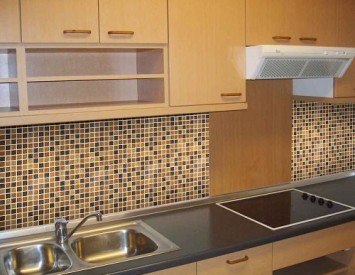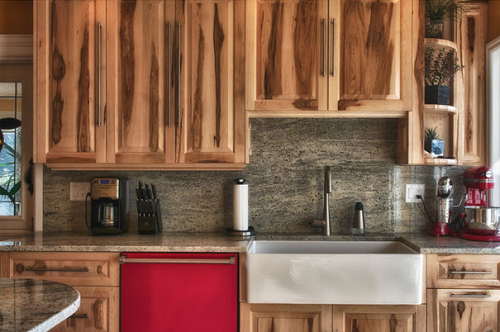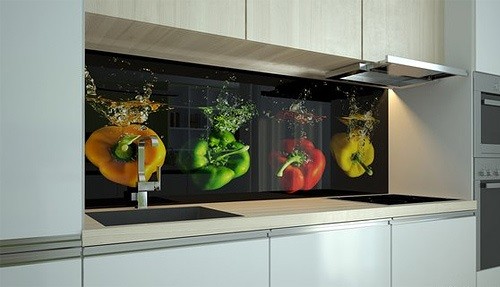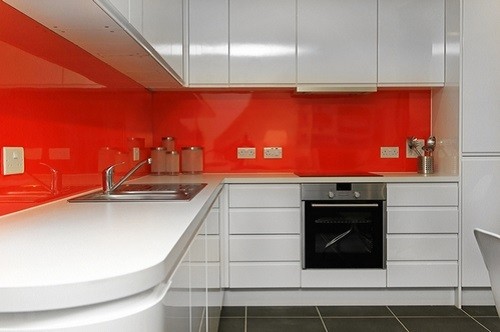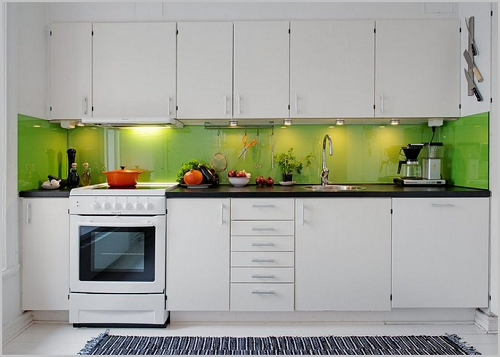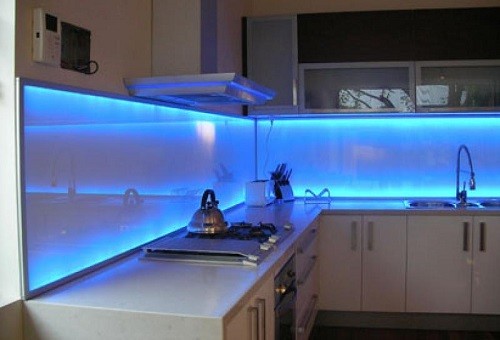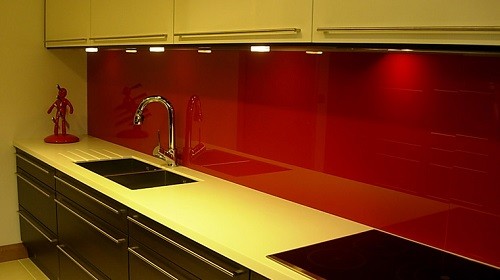The apron for the kitchen is not only a beautiful design element, but also a functional part. In the process of cooking on the walls, spots inevitably appear, drops from sauces, pieces of food, etc. fall. To protect the surface of the wall and facilitate cleaning, it is recommended to lay an apron made of easily washing materials - tiles, stone or glass. In this article we will tell you how to make an apron in the kitchen with your own hands.
Content
Preparatory moments
The apron in the kitchen improves the performance, and with correctly selected color and design - decorates and completes the interior of the room. With it, you can visually increase the space, emphasize the advantages of the kitchen set, hide the flaws of the layout. The variety of finishing materials makes it possible to implement the most original ideas. But start the construction of anything with the layout.
Apron design
First of all, it is necessary to decide on the design of the apron - to choose a form and color scheme. The coating should be combined not only with a kitchen set, but also with other elements - accessories, fittings, flooring, walls, ceiling. During the repair in the kitchen, many focus on the selection of wallpaper or flooring, completely forgetting about the apron, and it is he who gives the interior integrity.
How to choose the color of the apron:
- If neutral pastel shades dominate in the kitchen, but at the same time the walls and heads are contrasting with each other, they must be harmoniously tied into a single image. To do this, select the apron as close as possible to the headset, making it tone of cabinets or countertops.
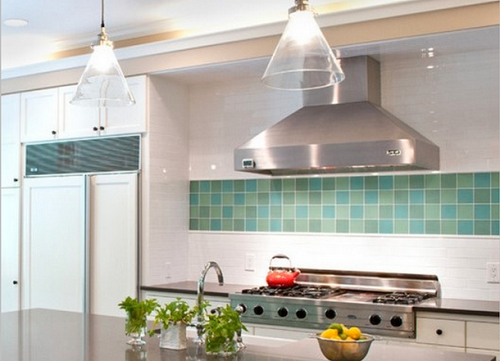
- If you plan to make the kitchen completely white, then the white apron will be “lost” in such a monotonous interior, so it should be made contrasting and bright. Use "juicy" colors that cause appetite. It is proved that not only “acid” shades (salad, yellow, orange), but also blue tones, starting from deep blue, ending with azure or indigo are capable of this. Such a bright apron is recommended to “support” with various accessories - shelves painted in tone, handles of cabinets, colorful vases or figurines. It is very important not to overdo it so that the exquisite interior does not turn into a clumsy bad taste.
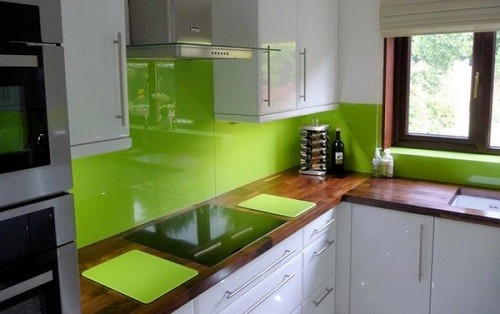
- If the situation is exactly the opposite, and a color set is installed in the kitchen, then the apron should maintain it not only in color, but also with texture. So, a contrasting dark apron of granite or artificial stone will look good for beige furniture. The apron, identical in texture and color with the countertop, looks very harmonious.
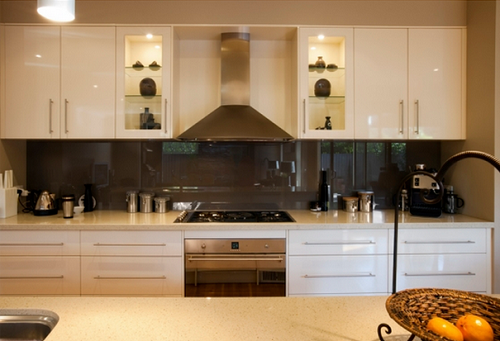
- The blue set looks good with the asphalt-gray apron. You can also use warmer shades (light-coffee, beige or cream-brown), then the warm tone will “soften” the cold blue notes of the headset and make the situation more comfortable. For a green headset, you can choose a green apron, but with a lighter or dark shade so that the kitchen does not merge into one spot.
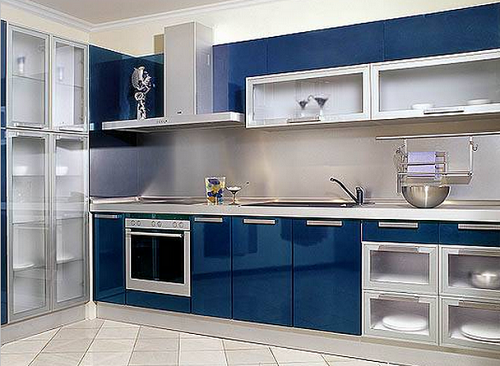
- The aprons of discreet tones are very original, bordered by the countertops with a bright ornament or folded from tiles of different tones of the same color scheme.
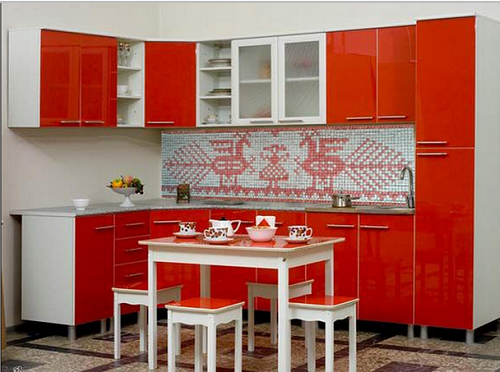
- The light tones of the aprons are also good in that when they get bored, you can apply or stick an interior vinyl sticker on top.
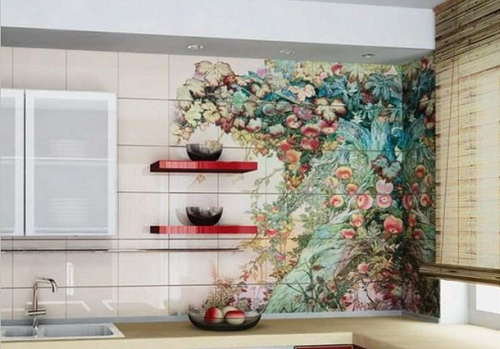
In most cases, the aprons are made of tiles, since it is the most affordable and suitable finishing material on the market, but if you are not constrained in the means, you can make the interior more stylish and original, constructing a stone or glass apron for the kitchen.
Materials for the apron
Let us consider in more detail each of the materials used to create kitchen aprons. The choice is determined not only by the color category, but also by the complexity of installation and operational characteristics. So, if even an inexperienced person can cope with the laying of tiles or artificial stone, then with glass panels the situation is much more complicated.
What to make an apron for the kitchen with your own hands:
- Tiles - among all finishing materials for the kitchen, the tile remains a favorite and does not collect to take up positions. It is inexpensive, quite easy to install, does not require special care, and the choice of colors allows you to implement any design whim. A ceramic apron for the kitchen is resistant to household chemicals, minor mechanical influences, temperature differences and, most importantly, humidity. Such a coating will last more than 10 years.
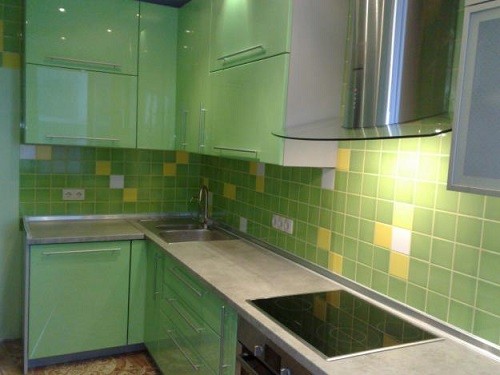
And if in Soviet times the choice of tiles was, to put it mildly, not rich, today you can “take a walk” and create real masterpieces of interior art. So, you can combine large elements with small mosaics, monotonous tiles with bright painted inserts, make patterns and ornaments. One of the most remarkable examples is Metlakhskaya tiles. This is a very durable finishing material, which is distinguished not only by durability, but also with absolutely amazing textures and colors.
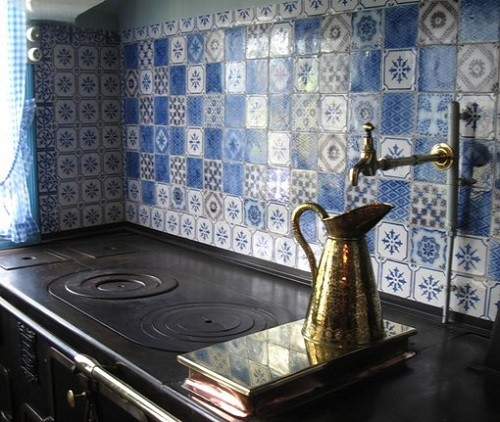
- Stone-if you always wanted a truly luxurious kitchen, your path lies in the department of finishing materials from natural and artificial stone. Make a countertop and apron from such material, and the kitchen will instantly be transformed. Basically, marble, granite or basalt is used to lay the apron. When choosing cladding from natural breeds, the physical characteristics of the stone should be taken into account. So, granite has a very dense structure, practically does not pass moisture and lasts several decades. Marble is a more whimsical breed and requires constant care. It has a rather porous structure, so if you spill red wine or acute tomato sauce on white marble, an unreasonable spot may remain. Therefore, after laying, the marble apron should be covered with a moisture -repellent protective agent.
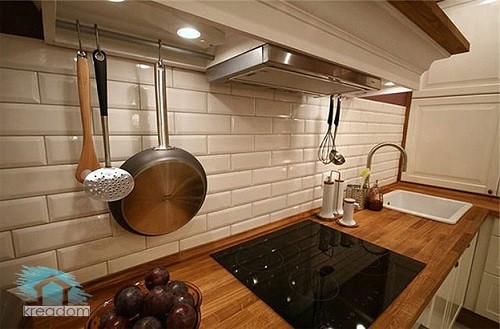
Aprons made of artificial stone are much cheaper and in many cases much more practical. Such materials are made on the basis of mineral filler (stone dust), acrylic resin and various pigments that give them the form of natural stones. The advantages of such a cladding are that it is very dense and has no pores, therefore it is not able to absorb moisture and leave memories of a sprayed borsch in the form of scarlet spots. Lithocamics is as simple in installation as ordinary tiles, even glued with the same glue. - MDF - such an apron will look perfect only if the adjacent countertop is made of MDF plate. This material allows not only to create an original interior, but also to align the surface of the wall. At the same time, it is mounted on ordinary liquid nails and basters, and the surface does not need preliminary preparation.
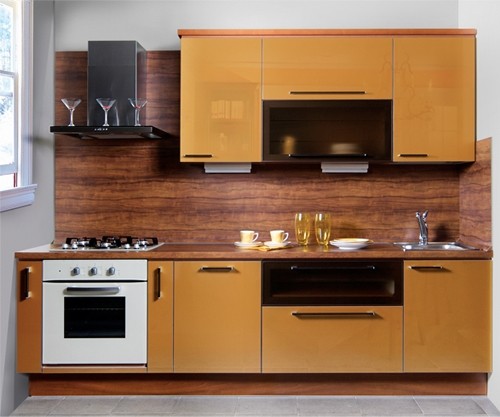
- Stainless steel is a very original and stylish solution that high-tech lovers will like. This material is used quite rarely, and completely in vain - it is absolutely fireproof, not susceptible to corrosion, environmentally friendly and extremely durable. If you decide to install a stainless steel apron, support it with elements of wood, glass or glossy plastic.
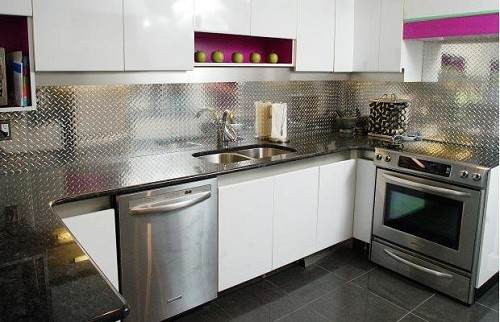
Laying tools
Since in this article we will tell you how to lay out the apron in the kitchen with tiles, we will select tools and materials in accordance with the installation technique. Before going to the store, make measurements and calculation of the required number of tiles. Buy with a margin to leave a few tiles in case of repair.
The necessary materials and equipment:
- tile;
- tile glue (recommended Ceresit CM11;
- deep penetration primer;
- grinding for seams (tone to tiles);
- construction level, plumb line;
- tile cutter;
- rubber spatula;
- toothed spatula;
- foam sponge;
- plastic crosses for tiles.
You will need skills in working with a tile cutter. For wall tiles, you can use the most ordinary manual mechanism.
Laying of a tile apron
Before starting work, give a rational assessment to your capabilities - if you are not sure that you can handle it, it is better to hire a specialist and not risk spoiling materials. For those who want to get a new interesting and useful experience, we have prepared detailed instructions for installing a apron in the kitchen.
Marking the apron
The first stage is the marking of the walls. This is an extremely important point on which the final result and the aesthetics of your masonry will depend. To make the right and clear markings, you must be able to use the building level. Ideally, it is better to get laser guides - they will significantly accelerate and facilitate the process.
Another important point - the walls before marking should be as smooth as possible. If there are problems with this, you will have to apply aligning plaster. Otherwise, you will have to compensate for the discrepancies due to the thickness of the glue during the installation of tiles.
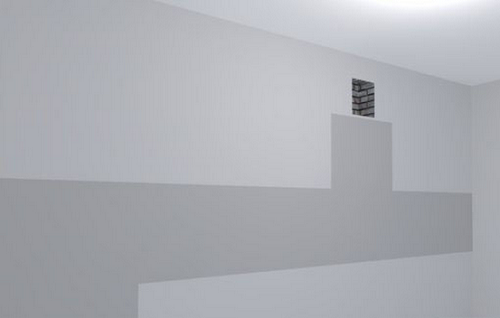
There are various standards for laying the height of the aprons in the kitchen, and this parameter should be selected in accordance with the dimensions of the kitchen set. On average, 80 cm is laid from the floor at a 75 cm height. Thus, it turns out to lay 7 tiles of a standard size of 10x10 cm in height, and 5 cm will remain on the seams.
Draw a horizontal line at the place of laying the first row of tiles. He will rely on a special rail. To do this, you can use an ordinary wooden bar or a metal profile. Screw the support to the wall with dowels and check the construction level.
Draw several vertical lines perpendicular to the bar to create additional landmarks.

Glue for styling
Another important point before starting work. It is recommended to plant tiles for the kitchen on the apron on the most popular Ceresit CM11 glue among professional builders. Small consumption will save you, unless, of course, the walls in the kitchen are even, and they do not need to be aligned by glue. So, at 5 square meters. m consumed approximately 12 kg of composition. When laying tiles on black walls, consumption may increase.
Stir the dry mixture of water according to the instructions using a construction mixer or a drill with a nozzle.
To lay the first row of tiles, which will be based on the bar, you should smear the wall with glue at a length of 3-4 tiles and quickly attach them until the composition has dried. To smear the glue, use a gear spatula so that shallow grooves remain on the surface - this will improve clutch and reduce the flow rate of the solution. Also, for better adhesion of glue with a wall, it is recommended to make small scratches with a knife-kosyak or the edge of a sharp screwdriver.
Laying tiles
Before laying, prepare materials that you may need in the process and arrange them at an extended hand: a spatula, crosses, a container with a solution, a stack of tiles.
The course of work:
- Make the notch on the wall with a screwdriver or hammer.
- Process the wall with a deep penetration primer.
- Screw the horizontal bar in accordance with the marking for laying the first row of tiles.
- Start laying tiles from the corner.
- Between the tiles, install plastic crosses, constantly controlling the position of the elements using the construction level. For tiles 10x10 cm in size, crosses 2.5 mm thick are suitable. You can lay crosses in different ways, but professionals recommend not installing one cross with 4 tiles, investing it in the opening, since it is very difficult to get it later. It is better not to save and put crosses sideways, so that later it is easy to pull out after drying the glue.

- When you glued 10-15 tiles, remove the glue from the seams until it froze completely. If you postpone it, the time for cleaning will take much more.
- Particular attention should be paid to sockets. It will be very useful, if they find themselves just where simple rectangular cuts can be made in the tile, but sometimes it is quite difficult to make them. To do this, you need a tile cutter, a couple of test tiles and 5-10 minutes of practice.
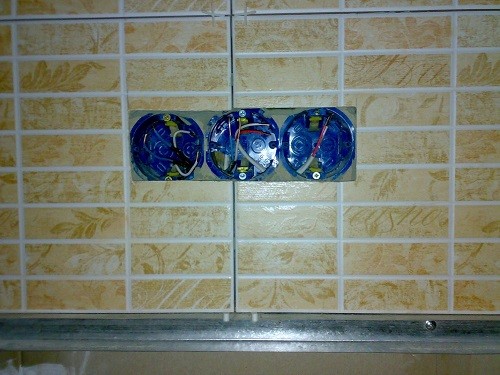
- When the last row is laid, leave the tile for a day, so that the glue properly grabs. After that, you can start grouting the seams. Dilute the composition to the consistency of a very thick sour cream and with a rubber spatula with a light pressure, fill the space between the tiles. Before that, do not forget to pull the crosses.
- When the grout freezes, burn uneven seams with fine sandpaper, and wipe the excess with a damp foam sponge (a sponge for washing cars is suitable).
Useful tips:
- To create an original design, order an apron for a kitchen with photo printing from MDF. It can be ornaments, images of fruits, vegetables, landscapes, etc. You can also put photos under the glass coating, make a collage or even paint the surface manually.
- Use LED backlight to give originality and organize additional lighting.
- The dimensions of the apron for the kitchen must correspond to the working area, capturing the sink, cutting table, the space of the plate.
- When choosing a tile, take into account that taking care of a smooth glazed surface is much easier than a relief.
- Apron for a kitchen of plastic can be an excellent alternative to tiles or MDF. Today on the market you can find high -strength plastic finishing materials that will last more than one year without having lost its original appearance.
- To create aprons, any materials suitable for operational characteristics can be used - they must be durable, moisture -proof and durable. River pebbles are ideally suited for these parameters - just imagine what surface can be laid out of simple pebbles brought from vacation! You can also use old coins or broken tiles for this.
- Mirror and glass tiles look original as a apron coating. To grind such a cladding, use a transparent silicone.
Video about laying a apron in a kitchen made of large tiles:
Apron for the kitchen, photo
We hope this article helped you figure out how to put an apron in the kitchen. Finally - several stylish design solutions.
